Papers by Patricia Phelps

Stem Cell Research & Therapy, 2013
Introduction: The reprogramming of a patient's somatic cells back into induced pluripotent stem c... more Introduction: The reprogramming of a patient's somatic cells back into induced pluripotent stem cells (iPSCs) holds significant promise for future autologous cellular therapeutics. The continued presence of potentially oncogenic transgenic elements following reprogramming, however, represents a safety concern that should be addressed prior to clinical applications. The polycistronic stem cell cassette (STEMCCA), an excisable lentiviral reprogramming vector, provides, in our hands, the most consistent reprogramming approach that addresses this safety concern. Nevertheless, most viral integrations occur in genes, and exactly how the integration, epigenetic reprogramming, and excision of the STEMCCA reprogramming vector influences those genes and whether these cells still have clinical potential are not yet known. Methods: In this study, we used both microarray and sensitive real-time PCR to investigate gene expression changes following both intron-based reprogramming and excision of the STEMCCA cassette during the generation of human iPSCs from adult human dermal fibroblasts. Integration site analysis was conducted using nonrestrictive linear amplification PCR. Transgene-free iPSCs were fully characterized via immunocytochemistry, karyotyping and teratoma formation, and current protocols were implemented for guided differentiation. We also utilized current good manufacturing practice guidelines and manufacturing facilities for conversion of our iPSCs into putative clinical grade conditions. Results: We found that a STEMCCA-derived iPSC line that contains a single integration, found to be located in an intronic location in an actively transcribed gene, PRPF39, displays significantly increased expression when compared with post-excised stem cells. STEMCCA excision via Cre recombinase returned basal expression levels of PRPF39. These cells were also shown to have proper splicing patterns and PRPF39 gene sequences. We also fully characterized the post-excision iPSCs, differentiated them into multiple clinically relevant cell types (including oligodendrocytes, hepatocytes, and cardiomyocytes), and converted them to putative clinical-grade conditions using the same approach previously approved by the US Food and Drug Administration for the conversion of human embryonic stem cells from research-grade to clinical-grade status.

Experimental neurology, Jan 8, 2015
The regenerative capacity of the adult CNS neurons after injury is strongly inhibited by the spin... more The regenerative capacity of the adult CNS neurons after injury is strongly inhibited by the spinal cord lesion site environment that is composed primarily of the reactive astroglial scar and invading meningeal fibroblasts. Olfactory ensheathing cell (OEC) transplantation facilitates neuronal survival and functional recovery after a complete spinal cord transection, yet the mechanisms by which this recovery occurs remain unclear. We used a unique multicellular scar-like culture model to test if OECs promote neurite outgrowth in growth-inhibitory areas. Astrocytes were mechanically injured and challenged by meningeal fibroblasts to produce key inhibitory elements of a spinal cord lesion. Neurite outgrowth of postnatal cerebral cortical neurons was assessed on three substrates: quiescent astrocyte control cultures, reactive astrocyte scar-like cultures, and scar-like cultures with OECs. Initial results showed that OECs enhanced total neurite outgrowth of cortical neurons in a scar-lik...

International Journal of Developmental Neuroscience
The receptor tyrosine kinase Met was identified recently as a novel regulator of cortical pyramid... more The receptor tyrosine kinase Met was identified recently as a novel regulator of cortical pyramidal dendritogenesis in vitro (Gutierrez et al., 2004), but its role in this process has not been investigated in vivo. Therefore, we used the loxP/cre system to delete exon 16 of the Met gene in all cells arising from the dorsal pallium in C57BL/6J mice, prior to neurogenesis. Specifically, the cre recombinase was under the control of the Emx1 promoter. We analyzed dendritic development in postnatal day 21 mice by MAP2 immunohistochemistry as previously described (Stanwood et al., 2005). Compared to littermate controls, cortical thickness and lamination as well as cytoarchitecture appear normal in the conditional null mice. However, there is an increase in both MAP2 staining and apical dendrite fasciculation throughout the cortices of these mice. Though the time of onset and the duration of dendritic disruption are currently unknown, these data demonstrate an over-elaboration of cortical pyramidal dendrites in cells lacking Met signalling, and suggest a negative regulatory role for Met in pyramidal dendritogenesis in vivo. Since a previous study has conversely shown cMet to play a positive role in pyramidal dendritogenesis when its signalling is first disrupted during postnatal periods (Gutierrez et al., 2004), we hypothesize that differences in the timing of Met attenuation during development may yield opposing effects on this process.

Neuroscience, Jan 19, 2007
L1 is a cell adhesion molecule associated with axonal outgrowth and fasciculation during spinal c... more L1 is a cell adhesion molecule associated with axonal outgrowth and fasciculation during spinal cord development and may reiterate its developmental role in adults following injury; L1 is upregulated on certain sprouting and regenerating axons in adults, but it is unclear if L1 expression is necessary for, or contributes to, regrowth of axons. This study asks if L1 is required for small-diameter primary afferents to sprout by conducting unilateral dorsal rhizotomies (six segments; T10-L2) on both wild-type and L1 mutant mice. First we determined that L1 co-localizes substantially with the peptidergic (calcitonin gene-related peptide; CGRP) but minimally with the nonpeptidergic (isolectin B4; IB4) primary afferents in intact wild-type and L1 mutant mice. However, we encountered a complication using IB4 to identify primary afferents post-rhizotomy; we detected extensive abnormal IB4 expression in the dorsal horn and dorsal columns. Much of this aberrant IB4 labeling is associated with...

Neuroscience, 1992
Small immunoreactive cholinergic neurons were detected in the main and accessory olfactory bulbs ... more Small immunoreactive cholinergic neurons were detected in the main and accessory olfactory bulbs of the rat with choline acetyltransferase immunocytochemistry. Such cells were also found in additional forebrain regions that received direct efferent innervation from the main olfactory bulb, such as the anterior olfactory nucleus, two subdivisions of the olfactory amygdala (nucleus of the lateral olfactory tract and anterior cortical nucleus), and the cortical-amygdaloid transition zone. Cholinergic neurons located in these olfactory-related regions were similar to each other morphologically and to those previously described by other investigators in the cerebral cortex, the hippocampus, and the basolateral amygdala. Somal measurements indicated that choline acetyltransferase-positive cells in olfactory-related regions were all essentially the same size, measuring 13-14 by 8-9 microns in major and minor diameters, respectively. In addition, these small cells were commonly bipolar in f...
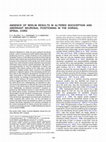
Neuroscience, 2006
Mutations in reeler, the gene coding for the Reelin protein, result in pronounced motor deficits ... more Mutations in reeler, the gene coding for the Reelin protein, result in pronounced motor deficits associated with positioning errors (i.e. ectopic locations) in the cerebral and cerebellar cortices. In this study we provide the first evidence that the reeler mutant also has profound sensory defects. We focused on the dorsal horn of the spinal cord, which receives inputs from small diameter primary afferents and processes information about noxious, painful stimulation. We used immunocytochemistry to map the distribution of Reelin and Disabled-1 (the protein product of the reeler gene, and the intracellular adaptor protein, Dab1, involved in its signaling pathway) in adjacent regions of the developing dorsal horn, from early to late embryonic development. As high levels of Dab1 accumulate in cells that sustain positioning errors in reeler mutants, our findings of increased Dab1 immunoreactivity in reeler laminae I-III, lamina V and the lateral spinal nucleus suggest that there are incorrectly located neurons in the reeler dorsal horn. Subsequently, we identified an aberrant neuronal compaction in reeler lamina I and a reduction of neurons in the lateral spinal nucleus throughout the spinal cord. Additionally, we detected neurokinin-1 receptors expressed by Dab1-labeled neurons in reeler laminae I-III and the lateral spinal nucleus. Consistent with these anatomical abnormalities having functional consequences, we found a significant reduction in mechanical sensitivity and a pronounced thermal hyperalgesia (increased pain sensitivity) in reeler compared with control mice. As the nociceptors in control and reeler dorsal root ganglia are similar, our results indicate that Reelin signaling is an essential contributor to the normal development of central circuits that underlie nociceptive processing and pain.

Neuroscience, 2006
Mutations in reeler, the gene coding for the Reelin protein, result in pronounced motor deficits ... more Mutations in reeler, the gene coding for the Reelin protein, result in pronounced motor deficits associated with positioning errors (i.e. ectopic locations) in the cerebral and cerebellar cortices. In this study we provide the first evidence that the reeler mutant also has profound sensory defects. We focused on the dorsal horn of the spinal cord, which receives inputs from small diameter primary afferents and processes information about noxious, painful stimulation. We used immunocytochemistry to map the distribution of Reelin and Disabled-1 (the protein product of the reeler gene, and the intracellular adaptor protein, Dab1, involved in its signaling pathway) in adjacent regions of the developing dorsal horn, from early to late embryonic development. As high levels of Dab1 accumulate in cells that sustain positioning errors in reeler mutants, our findings of increased Dab1 immunoreactivity in reeler laminae I-III, lamina V and the lateral spinal nucleus suggest that there are incorrectly located neurons in the reeler dorsal horn. Subsequently, we identified an aberrant neuronal compaction in reeler lamina I and a reduction of neurons in the lateral spinal nucleus throughout the spinal cord. Additionally, we detected neurokinin-1 receptors expressed by Dab1-labeled neurons in reeler laminae I-III and the lateral spinal nucleus. Consistent with these anatomical abnormalities having functional consequences, we found a significant reduction in mechanical sensitivity and a pronounced thermal hyperalgesia (increased pain sensitivity) in reeler compared with control mice. As the nociceptors in control and reeler dorsal root ganglia are similar, our results indicate that Reelin signaling is an essential contributor to the normal development of central circuits that underlie nociceptive processing and pain.

Neuroscience, 2012
The Reelin-signaling pathway regulates neuronal positioning during embryonic development. Reelin,... more The Reelin-signaling pathway regulates neuronal positioning during embryonic development. Reelin, the extracellular matrix protein missing in reeler mutants, is secreted by neurons in laminae I, II and V, binds to Vldl and Apoer2 receptors on nearby neurons, and tyrosine phosphorylates the adaptor protein Disabled-1 (Dab1), which activates downstream signaling. We previously reported that reeler and dab1 mutants had significantly reduced mechanical and increased heat nociception. Here we extend our analysis to chemical, visceral, and cold pain and importantly, used Fos expression to relate positioning errors in mutant mouse dorsal horn to changes in neuronal activity. We found that noxious mechanical stimulation-induced Fos expression is reduced in reeler and dab1 laminae I-II, compared to wild-type mice. Additionally, mutants had fewer Fos-immunoreactive neurons in the lateral-reticulated area of the deep dorsal horn than wild-type mice, a finding that correlates with a 50% reduction and subsequent mispositioning of the large Dab1-positive cells in the mutant lateral-reticulated area. Furthermore, several of these Dab1 cells expressed Fos in wild-type mice but rarely in reeler mutants. By contrast, paralleling the behavioral observations, noxious heat stimulation evoked significantly greater Fos expression in laminae I-II of reeler and dab1 mutants. We then used the formalin test to show that chemical nociception is reduced in reeler and dab1 mutants and that there is a corresponding decrease in formalin-induced Fos expression. Finally, neither visceral pain nor cold-pain sensitivity differed between wild-type and mutant mice. As differences in the nociceptor distribution within reeler and dab1 mutant dorsal horn were not detected, these differential effects observed on distinct pain modalities suggest that dorsal horn circuits are organized along modality-specific lines.
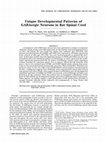
The Journal of Comparative Neurology, 2003
␥-aminobutyric acid (GABA)ergic neurons have been postulated to compose an important component of... more ␥-aminobutyric acid (GABA)ergic neurons have been postulated to compose an important component of local circuits in the adult spinal cord, yet their identity and axonal projections have not been well defined. We have found that, during early embryonic ages (E12-E16), both glutamic acid decarboxylase 65 (GAD65) and GABA were expressed in cell bodies and growing axons, whereas at older ages (E17-P28), they were localized primarily in terminal-like structures. To determine whether these developmental changes in GAD65 and GABA were due to an intracellular shift in the distribution pattern of GAD proteins, we used a spinal cord slice model. Initial experiments demonstrated that the pattern of GABAergic neurons within organotypic cultures mimicked the expression pattern seen in embryos. Sixteen-day-old embryonic slices grown 1 day in vitro contained many GAD65-and GAD67-labeled somata, whereas those grown 4 days in vitro contained primarily terminal-like varicosities. When isolated E14-E16 slices were grown for 4 days in vitro, the width of the GAD65-labeled ventral marginal zone decreased by 40-50%, a finding that suggests these GABAergic axons originated from sources both intrinsic and extrinsic to the slices. Finally, when axonal transport was blocked in vitro, the developmental subcellular localization of GAD65 and GAD67 was reversed, so that GABAergic cell bodies were detected at all ages examined. These data indicate that an intracellular redistribution of both forms of GAD underlie the developmental changes observed in GABAergic spinal cord neurons. Taken together, our findings suggest a rapid translocation of GAD proteins from cell bodies to synaptic terminals following axonal outgrowth and synaptogenesis.

The Journal of Comparative Neurology, 1982
The early postnatal development of neurons, dendrites and synaptic connectivity in kitten substan... more The early postnatal development of neurons, dendrites and synaptic connectivity in kitten substantia nigra (SN) was studied by light and electron microscopy. The compact and reticular divisions of the SN are present at birth but boundaries are indistinct. Most nigral neurons stain deeply in routine histological sections and their diameters increase slightly with age. Ultrastructurally, cell bodies are characterized by eccentrically located and often invaginated nuclei surrounded by cytoplasm rich in well-formed organelles. Axosomatic synapses are infrequent and cell surfaces are enveloped by glial processes. Immature dendritic features, including growth cones and filiform processes, are commonly observed during the first 10 days. Gradually the dendritic profiles elongate and thicken and contours become smoother, retaining only scattered spinelike appendages. Clear examples of the three synaptic types described in cat are found in newborn kittens, but immature terminals contain fewer synaptic vesicles and mitochondria. Approximately 90% of synapses present at birth in both nigra subdivisions are Type I, which contain large pleomorphic vesicles and contact dendrites symmetrically. Asymmetrical contacts characterize most of the remaining definable synapses. The postnatal increase in synaptic connectivity, which was estimated from random photographs of pars reticulata neuropil, is twofold during the first 50 days of life. Initially young dendrites are enveloped by glia and then gradually become ensheathed by axon terminals. Synaptogenesis in pars reticulata reflects the postnatal increase of neostriatal inputs to this subdivision and can be correlated with functional changes in strionigral connectivity.

The Journal of Comparative Neurology, 2000
The present study used nicotinamide adenine dinucleotide phosphate (NADPH)diaphorase histochemist... more The present study used nicotinamide adenine dinucleotide phosphate (NADPH)diaphorase histochemistry to identify populations of neurons containing nitric oxide synthase and to describe their putative migration during development of the human spinal cord. As early as week 6 (W6) of gestation, diaphorase expression was observed in sympathetic preganglionic neurons (SPNs) and interneurons of the ventral horn. As development proceeded, the SPNs translocated dorsally to form the intermediolateral nucleus, and the interneurons remained scattered throughout the ventral horn. In addition to the dorsal translocation of SPNs, a unique dorsomedially directed migratory pathway was observed. At later stages of development, other groups of SPNs were identified laterally in the lateral funiculus and medially in the intercalated and central autonomic regions. In addition, two "U-shaped" groups of diaphorase-labeled cells were identified around the ventral ventricular zone at W7. Cells of these groups appeared to translocate dorsally over the next weeks and presumably give rise to interneurons within the deep dorsal horn and surrounding the central canal. Furthermore, during W7-14 of gestation, the deep dorsal horn contained a number of diaphorase-positive cells, whereas the superficial dorsal horn was relatively free of staining. These data demonstrate that nitric oxide is present very early in human spinal cord development and that two unique cell migrations initially observed in rodents have now been identified in humans. Furthermore, nitric oxide may be expressed in some populations of neurons as they migrate to their final positions, suggesting that this molecule may play a role in neuronal development.
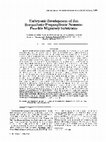
The Journal of Comparative Neurology, 1993
Spinal somatic and autonomic (sympathetic preganglionic) motor neurons are generated synchronousl... more Spinal somatic and autonomic (sympathetic preganglionic) motor neurons are generated synchronously and, subsequently, migrate from the ventricular zone together to form a common primitive motor column. However, these two subsets of motor neurons ultimately express several phenotypic differences, including soma1 size, peripheral targets, and spinal cord locations. While somatic motor neurons remain ventrally, autonomic motor neurons (AMNs) move both dorsally and medially between embryonic days 14 and 18, when they approximate their final locations in spinal cord. The goal of the present investigation was to determine the potential guidance substrates available to AMNs during these movements. The dorsal translocation was studied in developing upper thoracic spinal cord, because, at this level, the majority of AMNs are located dorsolaterally. Sections were double-labeled by ChAT (choline acetyltransferase) and SNAPiTAG-1 (stage-specific neurite associated proteinltransiently expressed axonal surface glycoprotein) immunocytochemistry to visualize motor neurons and the axons of early forming circumferential interneurons, respectively. Results showed that during the developmental stage when AWINs translocated dorsally, SNAP/TAG-1 immunoreactive lateral circumferential axons were physically located along the borders of the AMN region, as well as among its constituent cells. These findings indicate that lateral circumferential axons, as well as the SNAP/TAG-1 molecules contained upon their surfaces, are in the correct spatial and temporal position to serve as guidance substrates for AMNs. The medial translocation was studied in developing lower thoracic-upper lumbar spinal cord, because, a t this level, more than half of the AMNs are medially located. Sections were double-labeled by ChAT and vimentin immunocytochemistry to visualize motor neurons and radial glial fibers, respectively. Observations on consecutive developmental days of the medial translocation revealed that AMNs were aligned with parallel arrays of radial glial fibers. Thus, the glial processes could serve as guides for the AMN medial movement. Future experimental analyses will examine whether circumferential axons and radial glial fibers are in fact functioning as migratory guides during AMN development, and, if so, whether specific surface molecules on these guides trigger the subsequent differentiation of AMNs. ,CI 1993 ~i~e y-~i s s , Inc. Key words: spinal cord, autonomic motor neurons, choline acetyltransferase, SNAPITAG-1, vimentin, immunohistochemistry, astroglia 'gla). Furthermore, by E13, both subclasses of motor neurons express detectable levels of choline acetyltransferase (ChAT), and thus are committed to their cholinergic phenotype (Phelps et al., '91a). This commitment occurs one to two days after their terminal mitosis, but one to two days before their axons have established functional connections with their respective targets (Dennis et al., '81; Rubin, '85a,b; Phelps et al., '91a). Subsequent to E13, however, the development of somatic and autonomic motor neurons
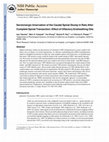
The Journal of Comparative Neurology, 2009
Spinal cord injury studies use the presence of serotonin (5-HT)-immunoreactive axons caudal to th... more Spinal cord injury studies use the presence of serotonin (5-HT)-immunoreactive axons caudal to the injury site as evidence of axonal regeneration. As olfactory ensheathing glia (OEG) transplantation improves hindlimb locomotion in adult rats with complete spinal cord transection, we hypothesized that more 5-HT-positive axons would be found in the caudal stump of OEG-than media-injected rats. Previously we found 5-HT-immunolabeled axons that spanned the transection site only in OEGinjected rats but detected labeled axons just caudal to the lesion in both media-and OEG-injected rats. Now we report that many 5-HT-labeled axons are present throughout the caudal stump of both media-and OEG-injected rats. We found occasional 5-HT-positive interneurons that are one likely source of 5-HT-labeled axons. These results imply that the presence of 5-HT-labeled fibers in the caudal stump is not a reliable indicator of regeneration. We then asked if 5-HT-positive axons appose cholinergic neurons associated with motor functions: central canal cluster and partition cells (active during fictive locomotion) and somatic motor neurons (SMNs). We found more 5-HT-positive varicosities in lamina X adjacent to central canal cluster cells in lumbar and sacral segments of OEGthan media-injected rats. SMNs and partition cells are less frequently apposed. As nonsynaptic release of 5-HT is common in the spinal cord, an increase in 5-HT-positive varicosities along motorassociated cholinergic neurons may contribute to the locomotor improvement observed in OEGinjected spinal rats. Furthermore, serotonin located within the caudal stump may activate lumbosacral locomotor networks.
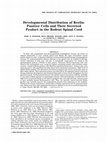
The Journal of Comparative Neurology, 2004
To date, only sympathetic and parasympathetic preganglionic neurons are known to migrate abnormal... more To date, only sympathetic and parasympathetic preganglionic neurons are known to migrate abnormally in reeler mutant spinal cord. Reelin, the large extracellular matrix protein absent in reeler, is found in wild-type neurons bordering both groups of preganglionic neurons. To understand better Reelin's function in the spinal cord, we studied its developmental expression in both mice and rats. A remarkable conservation was found in the spatiotemporal pattern of Reelin in both species. Numerous Reelin-expressing cells were found in the intermediate zone, except for regions containing somatic and autonomic motor neurons. A band of Reelin-positive cells filled the superficial dorsal horn, whereas only a few immunoreactive cells populated the deep dorsal horn and dorsal commissure. High levels of diffuse Reelin product were detected in the lateral marginal and ventral ventricular zones in both rodent species. This expression pattern was detected at all segmental spinal cord levels during embryonic development and remained detectable at lower levels throughout the first postnatal month. To discriminate between the cellular and secreted forms of Reelin, brefeldin A was used to block secretion in organotypic cultures. Such perturbations revealed that the high levels of secreted Reelin in the lateral marginal zone were derived from varicose axons of more medially located Reelin-positive cells. Thus, the laterally located secreted Reelin product may normally prevent the preganglionic neurons from migrating too far medially. Based on the strong evolutionary conservation of Reelin expression and its postnatal detection, Reelin may have other important functions in addition to its role in neuronal migration.
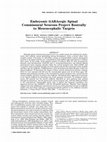
The Journal of Comparative Neurology, 2004
Although spinal commissural neurons serve as a model system for studying the mechanisms that unde... more Although spinal commissural neurons serve as a model system for studying the mechanisms that underlie axonal pathfinding during development, little is known about their synaptic targets. Previously we identified a group of ventromedially located commissural neurons in rat spinal cord that are ␥-aminobutyric acid (GABA)-ergic and express L1 CAM on their axons. In this study, serial sagittal sections of embryos (E12-15) were processed for glutamic acid decarboxylase (GAD)-65 and L1 immunocytochemistry and showed labeled commissural axons coursing rostrally within the ventral marginal zone. Both GAD65-and L1-positive axons extended rostrally out of the spinal cord into the central part of the medulla and then into the midbrain. GAD65-positive axons branched and ended abruptly within the lateral midbrain. To determine the targets of these ventral commissural neurons, embryos (E13-15) were injected with DiI into the ventromedial spinal cord. At all three ages, DiIlabeled axons projected rostrally in the contralateral ventral marginal zone, turned into the central medulla, and then traveled to the midbrain. DiI-labeled axons appeared to terminate in the lateral midbrain by branching into small, punctate structures. In reciprocal experiments, DiI injected into the lateral midbrain identified an axon pathway that coursed through the brainstem, into the spinal cord ventral marginal zone, and then filled cell bodies in the contralateral ventromedial spinal cord. A spatial and temporal coincidence was apparent between the GAD65/L1-and the DiI-labeled pathways. Together these findings suggest that some GABAergic commissural neurons are early projection neurons to midbrain targets and most likely represent a spinomesencephalic pathway to the midbrain reticular formation.
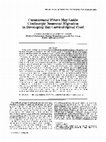
The Journal of Comparative Neurology, 1995
The present investigation examines the role of intercellular relationships in the guidance of neu... more The present investigation examines the role of intercellular relationships in the guidance of neuronal migration in embryonic rat cervical spinal cord. A "U-shaped" group of cholinergic neurons, was first detected on embryonic days (El 15.5-16 surrounding the ventral proliferative zone. At these stages, no cholinergic cells were observed in the dorsal spinal cord, but by E17, many of the "U-shaped" group of cholinergic cells appeared to have translocated dorsally, to become the cholinergic dorsal horn cells seen in older animals. Between El6 and E17, these choline acetyltransferase (ChAT)-immunoreactive cells displayed primitive processes oriented dorsoventrally, suggesting migration along that axis. Two early forming substrates present in embryonic spinal cord have been implicated in the guidance of other populations of migrating neurons: glial cells organized in radial arrays and commissural axons aligned along the dorsoventral axis. Involvement of the commissural fibers with cholinergic cell migration seems more likely because the fibers and the translocation pathway have similar orientations. In double-labeling immunocytochemical studies of E15.5-17 spinal cord, some immature ChATcontaining neurons were directly adjacent to commissural fibers, as identified by SNAPITAG-1 immunoreactivity. The temporal and spatial coincidence of developing cholinergic neurons and commissural axons is consistent with the hypothesis that these neurons could use commissural fibers as migratory guides. In addition, conventional electron micrographs were examined to determine if immature neuronal profiles were physically apposed to commissural axons. Immature neurons with leading and trailing processes oriented dorsally and ventrally, respectively, were embedded within and aligned along bundles of commissural fibers or along other similarly oriented neurons. This direct apposition of immature cells to the surfaces of commissural axons and other bipolar neurons is consistent with the hypothesis that the "U-shaped" group of cholinergic neurons may use commissural axons and other cohort neurons for guidance during their dorsal migration.

The Journal of Comparative Neurology, 2003
L1 is a cell adhesion molecule that is highly expressed on developing axons and is associated wit... more L1 is a cell adhesion molecule that is highly expressed on developing axons and is associated with neurite outgrowth, guidance, and fasciculation. In this study we systematically examined L1 expression at all spinal levels across eight postnatal ages to detect regional and developmental differences. We observed striking changes in the developmental pattern of L1 expression between birth (P0) and adult ages, with intense L1-immunopositive axons prevalent throughout the funiculi at P0 compared with predominantly L1-immunonegative funicular axons in adults. At all ages and spinal levels examined, some L1-positive dorsal root afferents entered the spinal cord, coursed in Lissauer's tract, and projected into the superficial dorsal horn and the dorsal columns, as well as across the dorsal commissure. Additional L1-positive axons were detected consistently around the perimeter of the spinal cord, in the dorsolateral funiculus, and adjacent to the central canal. While specific L1-labeled axons were detected at all ages, a pattern of segmental variation was observed within animals, with the highest levels of L1 expression detected in lumbar and sacral segments and the lowest in cervical spinal cord. The pattern of L1 immunoreactivity was compared to that of the growth-associated protein GAP-43 and the results indicated colabeling of most axons. These observations demonstrate that L1 is expressed on immature axons well into postnatal development, possibly until they have completed their differentiation. Furthermore, the L1-positive axons that continue to be detected in adults are likely to be either unmyelinated or sprouting axons.

The Journal of Comparative Neurology, 2005
The cell adhesion molecule L1 is highly expressed on embryonic axons and may play a role in axona... more The cell adhesion molecule L1 is highly expressed on embryonic axons and may play a role in axonal outgrowth and fasciculation. Generally only low levels of L1 are found in adult spinal cord except for intense labeling in Lissauer's tract, in laminae I-II, and on dorsolateral funicular axons. In this study we determine the source of L1 immunoreactivity in the dorsal spinal cord, the presence of L1 expression on sprouting axons, and the effect of exercise on L1 expression. We determined the source of L1 immunoreactivity in the superficial dorsal horn by performing acute unilateral rhizotomies (T12-L4) in adult rats. This resulted in a marked decrease in L1 expression in Lissauer's tract and laminae I-II on the deafferented side. The peptidergic and nonpeptidergic small-diameter primary afferent markers, calcitonin gene-related peptide (CGRP) and the lectin IB4 respectively, closely correlated with L1 expression and also decreased dramatically after rhizotomy. Considering its developmental role, we asked whether L1 was expressed on sprouting axons following chronic rhizotomy. L1 and CGRP, but not IB4, were detected on sprouting axons. Lastly, we investigated the effect of exercise on L1 expression by giving animals with chronic rhizotomies free access to an exercise wheel. After extensive exercise, L1, CGRP, and IB4 expression levels were unchanged compared with those of sedentary chronic animals. Combined, these data demonstrate that the dorsal root ganglia is a major source of L1-positive axons in the superficial dorsal horn, that both L1 and CGRP identify sprouting axons following rhizotomy, and that exercise does not upregulate L1 expression.

The Journal of Comparative Neurology, 1999
Previous studies used nicotinamide adenine diphosphate (NADPH)-diaphorase histochemistry as an in... more Previous studies used nicotinamide adenine diphosphate (NADPH)-diaphorase histochemistry as an indicator of nitric oxide synthase (NOS) expression in the adult mammalian cochlea. In this study, we investigated the early postnatal expression of diaphorase activity in the hamster cochlea. Two types of extrinsic fibers were intensely labeled as early as postnatal day 3 (P3) in the portion of the cochlear nerve that innervates the base of the modiolus. By P10, these fibers had reached the spiral ganglion and were projecting toward the organ of Corti. The perivascular type of fiber did not project into the organ of Corti; however, the nonperivascular type could be traced among the supporting cells below the outer hair cells. Spiral ganglion cell somata were also labeled as early as P3. The onset of diaphorase expression in the spiral ganglion cells corresponds to a critical period of synaptogenesis for these sensorineural cells. If NADPH-diaphorase activity is an indicator of NOS, then our results suggest that NO may play a role during postnatal cochlear development.

The Journal of Comparative Neurology, 1999
Early-forming commissural neurons are studied intensively as a model of axonal outgrowth and path... more Early-forming commissural neurons are studied intensively as a model of axonal outgrowth and pathfinding, yet the neurotransmitter phenotype of the majority of these neurons is not known. The present study has determined that a substantial number of commissural neurons express the 65-kDa isoform of glutamic acid decarboxylase (GAD65) as early as embryonic day 12 (E 12). Patterns of GAD65 localization were compared with those of TAG-1, the Transiently expressed Axonal Glycoprotein that is the best known marker of commissural axons. On E13, both GAD65- and TAG-1-labeled commissural axons emanate from similar lateral and ventromedial regions. However, dorsally located TAG-1-positive commissural axons were GAD65-negative. These results suggest that commissural neurons have both gamma-aminobutyric acid (GABA)ergic and non-GABAergic phenotypes. The intensity of GAD65 staining within commissural somata and axons decreased between E14-15 and continued to decline during embryonic development, whereas terminal-like structures in surrounding neuropil increased dramatically. This sudden loss of somatic and axonal GAD65 staining was unexpected and could be interpreted as commissural neurons only transiently expressing the GABAergic phenotype. Further experiments were undertaken to identify commissural neurons with other established GABAergic markers, GAD67 and GABA. When antibody labeling of the two GAD isoforms was compared, GAD67 was detected 1 day later than GAD65, and in a different subcellular distribution. In contrast to GAD65, GAD67 intensely stained somata but labeled few commissural axons. GABA immunoreactivity also was detected in commissural axons 1 day after GAD65, and the labeling pattern between E13 and E16 resembled that of GAD67 rather than GAD65. When GAD and GABA results were compared, it was clear that a number of ventrally located commissural neurons expressed and maintained the GABAergic phenotype during embryonic development. However, the early expression and subcellular redistribution of GAD65 suggests that the GAD isoforms are differentially regulated. The function of the transient GAD65 expression in commissural somata and axons is unknown, but its temporal expression pattern parallels the transient expression of TAG-1, as both are expressed during the early stages of commissural axon outgrowth and pathfinding.


Uploads
Papers by Patricia Phelps